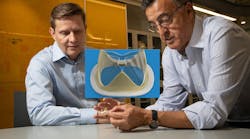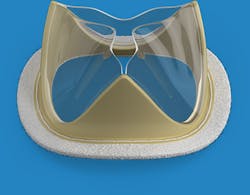Biomedical researchers at the California Institute of Technology, working with engineers from Foldax Inc. have developed an artificial heart valve that is longer-lasting, cost-effective to make, and more biocompatible than other valve options available to patients. As part of its FDA trial, one of the new valves was recently implanted into a human for the first time this past summer.
Aortic valve disease affects the valve between the heart’s main pumping chamber and the body’s main artery and can be either congenital, age-related, or the result of other diseases. The new heart valve, the Tria, has three flaps, or leaflets, connected by flexible tissue. As the heart beats and pumps blood through the valve, the flexible tissue bends outward, opening the valve. In between the beats, the flexible tissue bends back in, closing the valve and preventing blood from flowing backward into the heart.
The heart valve from Foldax is robotically made of polymers.
When these natural leaflets become diseased, they stiffen and impede blood flow. Individuals with diseased valves often require open heart surgery to replace the malfunctioning valve, for which they have had two options: a mechanical valve or a tissue valve.
Mechanical valves are crafted from synthetic materials such as pyrolytic carbon, and are the more durable option, but patients who get them must take blood thinners the rest of their lives to prevent blood clotting. Tissue valves, which are painstakingly hand-stitched from animal heart tissue (usually pigs) present less risk of causing clots and cellular damage but are less durable than mechanical valves, due to calcification and general wear-and-tear. Both are expensive options.
In contrast, the Tria valve uses a newly developed biopolymer, Lifepolymer, coupled with a bioinspired shape to create a valve that will last decades without calcification, risk of clotting, or damage to red blood cells. There are no animal cells or products. In testing, one valve already has lasted 600 million cycles, the equivalent of about 15 years, without significant wear-and-tear. Lifepolymer was key to the valve’s performance was developed in partnership with Australia’s national science agency.
The valve can replace diseased aortic, mitral, and tricuspid heart valves. It has a larger orifice area than conventional hand-stitched valves, and this creates hemodynamics and blood flow similar to natural human heart valves. The valves are also robotically manufactured for the highest levels of quality and precision, while eliminating the variability of human production
The next iteration of the valve, which Gharib has already designed in prototype with Foldax, can be inserted into the heart via a minimally invasive catheter.


